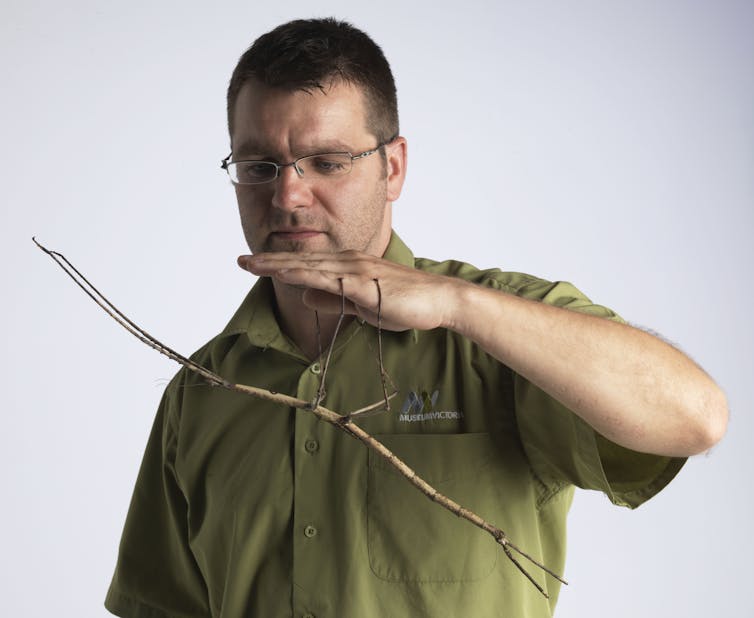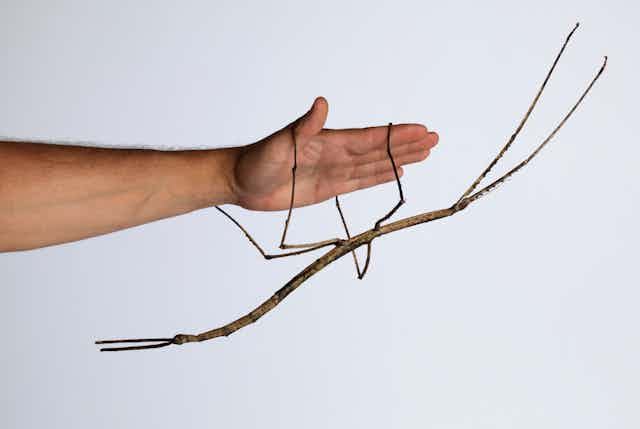It’s not often you get to raise a clutch of stick insects that can grow to nearly 60cm long. But I was given the rare privilege of doing so recently when I nursed the batch of eggs laid by the longest Australian phasmid, Ctenomorpha gargantua, nicknamed “Lady Gaga-ntuan”.
Lady Gaga (for short) was discovered and collected in January 2014 and laid 12 eggs during her remaining weeks of captivity. Almost nothing is known about this species’ biology, and despite its size, females seem to be very elusive.
Being the first ever adult female of this species in captivity, Live Exhibits at Melbourne Museum had to make the most of her and her eggs, which were to kick start a new population and secure that species in captivity.
So, the eggs were passed onto me with the hope they were fertile and faith in my ability to rear a new generation of the giant phasmids. Due to my background in keeping various phasmid species overseas, and having now set up several phasmid colonies privately, I had a good feeling about this.
Another upside to raising the animals at home was that I’d have the opportunity to monitor activity patterns and feeding behaviour throughout the night.
Finding the diet
I set up the eggs for incubation just like I would most of my other phasmid eggs: I placed them on a mix of 50% sand and 50% coco peat in a simple takeaway container. I sprayed it once or twice a week, but never let it dry out completely.
We didn’t know whether the eggs were even fertile, so it was a terrific surprise when the first nymph hatched on September 7, 2014.
I offered the newly hatched nymph fresh Eucalypt, which it readily accepted. It wasn’t necessary to trial possible food plants, as Jack Hasenpusch (owner of Australian Insect Farm) managed to rear a nymph on potted Eucalypt. Unfortunately it didn’t survive to adulthood, but it gave us a good indication on food plant acceptance.
Three days after the first nymph, a second and third hatched, and by October 2, seven nymphs had hatched. The other five eggs are very likely to be infertile.
I started raising all nymphs together in a mesh cage, which I placed into a reptile melamine enclosure with temperature controlled by a thermostat. The background temperature was set to 28C and I mist sprayed the whole cage in the morning and in the evening to supply at least 85%-95% humidity.
To avoid over-handling, I only supplied potted food plants instead of cut branches, and changed them when most of them were eaten. The plant species were chosen with regard to the plant species we have here at the Melbourne Museum.
I’ve rotated lilly pilly (Syzygium australae), brittle gum (Eucalyptus mannifera) and mountain ash (Eucalyptus regnans), which were equally well eaten.

Through the woods
The nymphs were growing and progressing fast, but by the time they had their third moult, some animals seemed very sluggish and wouldn’t move for days.
That concerned me a lot, so I started feeding leaves directly into their mouths. After four days, five out of seven nymphs were immobile and wouldn’t accept any leaves when offered.
I drip fed these animals glucose with no effect and made the decision to totally modify the husbandry process and save what was possible.
I moved the mesh enclosure out of the reptile enclosure, with the attempt to keep them only at a non-stable room temperature, but more air movement and only mist spray once a day.
The five immobile nymphs were individually offered thinly sliced apple, which was readily eaten. The next day, all seven nymphs were feeding on potted mountain ash and have had no other issues during their development.
They all went through the next moult without any problems, and by that time I was able to distinguish the sexes. Males were slim build and had a bulging sub genital plate, which was lacking in females. Also, the cerci in female nymphs were much longer as well.
A total of three male and four female nymphs suggested that “Lady Gaga-ntuan” had mated with a male and didn’t reproduce parthenogenically.
Due to the lower ambient temperature, the nymphs took a long time to develop. The first animal that moulted into adulthood was a male, on October 6, 2015, more than one year after hatching. Within four weeks, all of the animals had their final moult.

World record contenders
Every one of the four females exceeds their mother, Lady Gaga-ntuan, in size, with the longest being a proud 56.5cm in total length.
All three males have been mated across the four females, which have started laying already.
With perfect climate conditions and suitable browse, I’m confident to say that it is without doubt possible to produce specimens up to two feet (61cm) in length, which will make this insect the worlds longest.
At present, two adult females and one adult male are still alive and are on permanent display at the museum.
It has been a great opportunity for me to rear this interesting species for the first time and pave the way to establish and secure the captive stock. The eggs will be incubated and later reared at Live Exhibits in order to build up sufficient numbers for displaying Australia’s (and possibly the world’s) longest stick insect.

